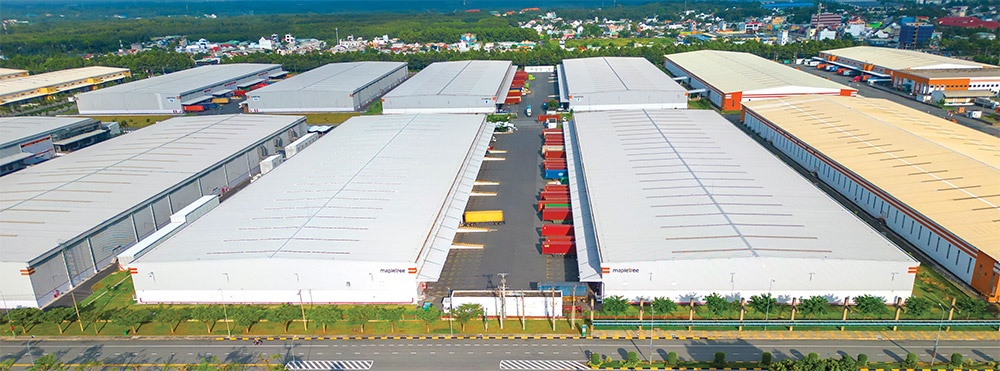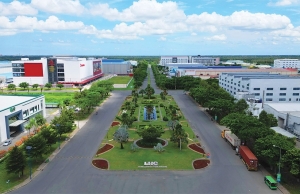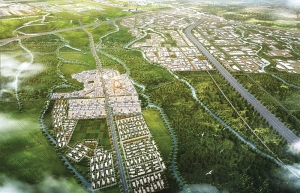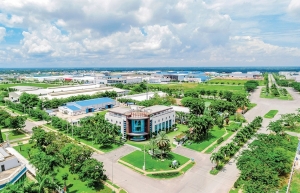Precise planning vital for relocation of IPs
Vietnam is pushing for sustainable development in its industrial parks, which cover more than 89,000 hectares across almost 420 parks.
 |
| Timothy D. Van Epp, fellow of the American Institute of Certified Planners (left), and Mai Nguyen of the American Planning Association’s International Division |
According to a survey by the Vietnam Chamber of Commerce and Industry for the first quarter, while 298 parks are operational and 120 are under construction, only half of industrial park (IP) management representatives are aware of eco-industrial practices. Challenges underscored by these representatives include financial constraints, limited investor capacity, and unclear legislation.
The government is prioritising the transition to eco-IPs by improving resource efficiency and legal frameworks to attract investments and support sustainable growth. Ho Chi Minh City in particular plans to develop eco-IPs to draw in investment and align with its green growth strategy. The city has 17 IPs and zones, employing over 280,000 workers.
A comprehensive plan for this transition will be submitted by the end of this year, supporting Vietnam’s goal of net-zero emissions by 2050 despite challenges in administrative procedures and policy implementation.
The initiative, funded by the Swiss government and managed by the United Nations Industrial Development Organization and the Ministry of Planning and Investment, aims to integrate eco-IP practices into national policies. Since 2020, three IPs – Deep C, AMATA City Bien Hoa, and Hiep Phuoc – demonstrated increased compliance with international eco-IP standards.
Relocating IPs promises many foreseeable benefits, yet the process presents significant challenges and opportunities to draw from experience. The inevitability of sustainable IPs, prompts the question of how strategies can be devised to mitigate negative impacts and foster post-relocation success. Comprehensive planning for both current and new locations is imperative in addressing these considerations.
Planning for existing locations
When an IP leaves a city neighbourhood, there can be job losses and reduced local economic demand. The vacated buildings and land might be repurposed, but contamination by hazardous chemicals may require clean-up before reuse. This process varies locally, influenced by the type of IP, economic conditions, land use, community concerns, and plans for future development. Adapting buildings and managing transitions require tailored solutions based on these factors, as a one-size-fits-all approach is ineffective.
Several steps could be considered. First is to assess the economic consequences of the IP’s departure, including job losses and the impact on local goods and services demand. Assess whether the new park will sufficiently mitigate these losses and maintain economic activity levels. A midterm transition plan from now to 2030, along with a longer-term plan extending to 2050, appears reasonable.
Next is to explore adaptive reuse options for existing buildings left behind by the IP and identify potential new uses for the land, ensuring alignment with zoning regulations and meeting the diverse needs of the local community. Options include residential developments, commercial expansions, or public spaces. These decisions must be made after thorough consideration of economic and social impacts and particularly environmental studies.
Assessments must be conducted for hazardous chemical contamination in buildings, soil, surface water, and groundwater. Clean-up efforts have to be planned and executed to ensure the safe and productive reuse of the land and buildings. This task should be carried out by local authorities carefully to avoid any residual impacts on future urban wellbeing, and any remaining limitations on land and building use due to contamination and determine strategies should be identified to mitigate these limitations.
A transition management plan should be developed to guide the community through changes resulting from the IP relocation. Stakeholders – including residents, businesses, and government agencies – must be engaged in planning for social, economic, and environmental improvements.
Finally, it is key to consider local conditions such as the type of IP, mix of tenants, economic conditions, surrounding land uses, and community concerns. Solutions can be tailored accordingly to address specific local challenges and opportunities for enhancing community wellbeing.
 |
Feasibility and engagement
Planning new IPs is not an entirely new exercise. Yet, this time, we have the opportunity to draw from past lessons, enhance current good practices, and integrate sustainability into our long-term vision.
It’s not just about replacing the old with the new. The transition process holds significant importance. Relocating industrial facilities is one aspect, while relocating hundreds of thousands of workers and their families is equally, if not more, complex. Therefore, planning for the new location entails more than IP planning; it’s akin to planning for a new city.
Feasibility studies should be the first step, which covers assessing the feasibility of establishing a new IP, considering economic viability, market demand, and environmental impact assessments. Define the objectives of the new IP, including its size, target industries, and alignment with global IP trends such as industrial symbiosis and circular economy practices.
We must elect an appropriate location that can accommodate a larger IP, provide adequate buffer zones from residential areas, and offer environmental benefits like centralised infrastructure for wastewater treatment and solid waste management. It is also important to engage with local communities, businesses, government agencies, and environmental experts to ensure alignment with community needs and environmental regulations.
Planning and developing necessary infrastructure such as roads, utilities, and environmental management facilities to support industrial operations and mitigate environmental impacts is also vital. Implementing measures to minimise air and noise pollution from industrial and transportation sources is needed, including creating buffer zones and installing sound barriers.
Promotion and encouragement of sustainable practices within the IP, such as energy efficiency, waste reduction, and recycling initiatives, can support a circular economy. We must ensure compliance by adhering to regulatory requirements concerning land use, environmental protection, and safety standards throughout all phases of development and operation.
Continuously assessing environmental impacts is also crucial, including enhancing sustainability practices, and adapting plans based on feedback and technological advancements. It is essential to evaluate and improve overall eco-IP performance for better operation, and establish and implement a process and criteria for evaluating the overall performance of the eco-IP relative to its intentions.
To support the relocation to the new industrial park, several measures can be considered. These include transportation such as providing buses from the old town to the new location to ensure convenient transportation, affordable housing options to accommodate workers, job training programs to equip workers with the necessary skills for jobs in the relocated park, access to healthcare and educational institutions, community amenities such as parks, shopping centers, and recreational facilities.
To facilitate a smooth relocation process, foster consensus, and ensure benefits for both businesses and workers, Binh Duong province has planned supportive policies. These policies for workers will encompass support during business production halts, unemployment benefits for those displaced by the relocation, social insurance coverage, and additional assistance. For businesses required to relocate, the provincial budget will offer support through industrial promotion funds, incentives for industrial projects, loan assistance, aid for renting land and factories at new locations, and other forms of support.
These support plans are commendable but require more detailed implementation strategies. The studies and assessments mentioned above could provide valuable insights for local authorities to effectively identify and quantify their specific support for industrial property owners, workers, and the involved community.
The transitional period can present challenges that require special incentives and support measures for workers affected by IP relocation. Comprehensive support initiatives aim to foster a supportive environment that promotes the wellbeing and successful integration of workers into the new park location. This approach helps build resilient communities, enhances their wellbeing, and supports them in maintaining a healthy lifestyle, ultimately fostering productivity.
Sharing good practices and experiences among provinces and IP owners is critical to fostering mutual support. Ministries and local authorities should establish close communication channels to facilitate this exchange effectively.
Although planning should be adapted to fit the unique circumstances and needs of the affected urban area, a general guideline issued by the ministries could play an important role in accelerating this transitional period, especially when eco-IPs are prioritised.
 | Real estate developers pin hopes on eco-IP regulations Industrial real estate developers are waiting for a new law to open the path for developing greener models of industrial parks. |
 | Industrial parks strive to level up Industrial, service, and urban zones with smart technology application in operation and management of technical infrastructure will become hot development trends in the Vietnamese market, especially when it comes to some of the nation’s biggest foreign investors. |
 | Addressing the barriers to building eco-industrial parks Vietnam, a nation experiencing rapid industrialisation and economic growth, stands at a pivotal point in its developmental trajectory. Rizwan Khan, managing partner, at Acclime Vietnam, looks at the importance of sustainable development and the progress of implementing greener industrial areas. |
 | Incentives can boost eco-IP ambitions Encouraging the development of new models of industrial parks, including eco-industrial parks, is considered one of the most outstanding impacts of Decree No.35/2022/ND-CP on the management of parks and economic zones. |
What the stars mean:
★ Poor ★ ★ Promising ★★★ Good ★★★★ Very good ★★★★★ Exceptional
Related Contents
Latest News
More News
- Amata plans industrial park in Ho Chi Minh City (November 04, 2025 | 15:49)
- Businesses honoured for building a green future at VIPF 2025 (October 30, 2025 | 13:00)
- Vietnam’s growth formula evolves as high-tech and green industries take lead (October 30, 2025 | 08:34)
- Building Vietnam’s green industrial future: materials, mindset, and resource efficiency (October 29, 2025 | 20:00)
- Vietnam navigates complex landscape to accelerate strategic FDI (October 29, 2025 | 19:00)
- SLP charts strategic path through Vietnam’s industrial real estate market (October 29, 2025 | 18:06)
- VIPF 2025 highlights Vietnam’s evolving real estate landscape (October 29, 2025 | 18:03)
- Industrial expansion accelerates across northern Vietnam (October 29, 2025 | 15:21)
- Soilbuild offerings strengthen Vietnam’s standing (October 27, 2025 | 11:40)
- RSL Group elevates ready-built factory construction for lease (October 23, 2025 | 14:59)

 Tag:
Tag:






















 Mobile Version
Mobile Version